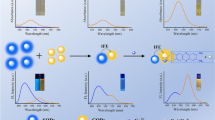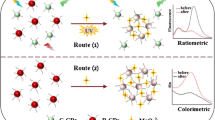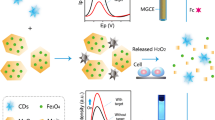Abstract
A sensing platform with both ratiometric fluorescence and colorimetric responses towards copper(II) ions (Cu2+) and D-penicillamine (D-pen) was constructed based on carbon dots (CDs). o-Phenylenediamine (OPD) was employed as a chromogenic development reagent for reaction with Cu2+ to generate the oxidation product 2,3-diaminophenazine (oxOPD), which not only emits green fluorescence at 555 nm, but also quenches the blue fluorescence of CDs at 443 nm via the inner filter effect (IFE) and Förster resonance energy transfer (FRET). Additionally, oxOPD exhibits obvious absorption at 420 nm. Since the intense chelation affinity of D-pen to Cu2+ greatly inhibits the oxidation of OPD, the intensity ratio of fluorescence at 443 nm to that at 555 nm (F443/F555) and the absorbance at 420 nm (A420) were conveniently employed as spectral response signals to represent the amount of D-pen introduced into the testing system. This dual-signal sensing platform exhibits excellent selectivity and sensitivity towards both Cu2+ and D-pen, with low detection limits of 0.019 μM and 0.092 μM, respectively. In addition, the low cytotoxicity of the testing reagents involved in the proposed sensing platform facilitates its application for live cell imaging.
Graphical abstract








Similar content being viewed by others
References
Bieri M. D-Penicillamine adsorption on gold: an in situ ATR-IR spectroscopic and QCM study. Langmuir. 2006;22:8379–86.
Kim HA, Song YW. A comparison between bucillamine and D-penicillamine in the treatment of rheumatoid arthritis. Rheumatol Int. 1997;17:5–9.
Preedy VR, Wassif WS, Baldwin D, Jones J, Falkous G, Marway JS, Mantle D, Scott DL. Skeletal muscle protein loss due to D-penicillamine results from reduced protein synthesis. Int J Biochem Cell B. 2001;33(10):1013–26.
Cope-Yokoyama S, Finegold MJ, Sturniolo GC, Kim K, Mescoli C, Rugge M, Medici V. Wilson disease: histopathological correlations with treatment on follow-up liver biopsies. World J Gastroenterol. 2010;16(12):1487–94.
Joly D, Rieu P, Mejean A, Gagnadoux MF, Daudon M, Jungers P. Treatment of cystinuria. Pediatr Nephrol. 1999;13(9):945–50.
Dodani SC, Firl A, Chan J, Nam CI, Aron AT, Onak CS, Ramos-Torres KM, Paek J, Webster CM, Feller MB, Chang CJ. Copper is an endogenous modulator of neural circuit spontaneous activity. Proc Natl Acad Sci U S A. 2014;111(46):16280–5.
Chen J, Jiang Y, Shi H, Peng Y, Fan X, Li C. The molecular mechanisms of copper metabolism and its roles in human diseases. Pflugers Arch. 2020;472(10):1415–29.
Uriu-Adams JY, Keen CL. Copper, oxidative stress, and human health. Mol Asp Med. 2005;26(4-5):268–98.
Sarkar B. Treatment of Wilson and Menkes diseases. Chem Rev. 1999;99:2535–44.
Xu X, Ray R, Gu Y, Ploehn HJ, Gearheart L, Raker K, Scrivens WA. Electrophoretic analysis and purification of fluorescent single-walled carbon nanotube fragments. J Am Chem Soc. 2004;126(40):12736–7.
Sun YP, Zhou B, Lin Y, Wang W, Fernando KA, Pathak P, Meziani MJ, Harruff BA, Wang X, Wang H, Luo PG, Yang H, Kose ME, Chen B, Veca LM, Xie SY. Quantum-sized carbon dots for bright and colorful photoluminescence. J Am Chem Soc. 2006;128(24):7756–7.
Yang ST, Cao L, Luo PG, Lu F, Wang X, Wang H, Meziani MJ, Liu Y, Qi G, Sun YP. Carbon dots for optical imaging in vivo. J Am Chem Soc. 2009;131(32):11308–9.
Peng H, Zhang L, Kjallman TH, Soeller C, Travas-Sejdic J. DNA hybridization detection with blue luminescent quantum dots and dye-labeled single-stranded DNA. J Am Chem Soc. 2007;129(11):3048–9.
Weng CI, Chang HT, Lin CH, Shen YW, Unnikrishnan B, Li YJ, Huang CC. One-step synthesis of biofunctional carbon quantum dots for bacterial labeling. Biosens Bioelectron. 2015;68:1–6.
Chen BB, Liu ML, Zhan L, Li CM, Huang CZ. Terbium(III) modified fluorescent carbon dots for highly selective and sensitive ratiometry of stringent. Anal Chem. 2018;90(6):4003–9.
Wei Z, Li H, Liu S, Wang W, Chen H, Xiao L, Ren C, Chen X. Carbon dots as fluorescent/colorimetric probes for real-time detection of hypochlorite and ascorbic acid in cells and body fluid. Anal Chem. 2019;91(24):15477–83.
Zhang ZD, Baeyens WRG, Zhang XR, Weken GVD. Chemi luminescence determination of penicillamine via flow injection applying a quinine-cerium(iv) system. Analyst. 1996;121:1569.
Yuan Y, Zhao X, Liu S, Li Y, Shi Y, Yan J, Hu X. A fluorescence switch sensor used for D-Penicillamine sensing and logic gate based on the fluorescence recovery of carbon dots. Sensors Actuators B Chem. 2016;236:565–73.
Rojanarata T, Opanasopit P, Ngawhirunpat T, Saehuan C. Ninhydrin reaction on thiol-reactive solid and its potential for the quantitation of D-penicillamine. Talanta. 2010;82(2):444–9.
Kumar DR, Baynosa ML, Dhakal G, Shim JJ. Sphere-like Ni3S4/NiS2/MoOx composite modified glassy carbon electrode for the electrocatalytic determination of D-penicillamine. J Mol Liq. 2020;301:112447.
Zeeb M, Ganjali MR, Norouzi P, Moeinossadat SR. Selective determination of penicillamine by on-line vapor-phase generation combined with Fourier transform infrared spectrometry. Talanta. 2009;78(2):584–9.
Keating LR, LaCourse WR. Indirect pulsed electrochemical detection following high-performance reversed-phase liquid chromatography. Talanta. 2019;199:155–63.
Xu S, Zhang F, Xu L, Liu X, Ma P, Sun Y, Wang X, Song D. A fluorescence resonance energy transfer biosensor based on carbon dots and gold nanoparticles for the detection of trypsin. Sensors Actuators B Chem. 2018;273:1015–21.
Liu Y, Zhang Y, Zhang X, Zhang W, Wang X, Sun Y, Ma P, Huang Y, Song D. Near-infrared fluorescent probe based on ag&Mn:ZnInS QDs for tyrosinase activity detection and inhibitor screening. Sensors Actuators B Chem. 2021;344:130234.
Becker JS, Matusch A, Depboylu C, Dobrowolska J, Zoriy MV. Quantitative imaging of selenium, copper, and zinc in thin sections of biological tissues (slugs-genus Arion) measured by laser ablation inductively coupled plasma mass spectrometry. Anal Chem. 2007;79:6074–80.
Ndokoye P, Ke J, Liu J, Zhao Q, Li X. L-cysteine-modified gold nanostars for SERS-based copper ions detection in aqueous media. Langmuir. 2014;30(44):13491–7.
Ozkantar N, Yilmaz E, Soylak M, Tuzen M. Pyrocatechol violet impregnated magnetic graphene oxide for magnetic solid phase microextraction of copper in water, black tea and diet supplements. Food Chem. 2020;321:126737.
Zaksas NP, Gerasimov VA, Nevinsky GA. Simultaneous determination of Fe, P, Ca, Mg, Zn, and Cu in whole blood by two-jet plasma atomic emission spectrometry. Talanta. 2010;80(5):2187–90.
Xu Z, Meng Q, Cao Q, Xiao Y, Liu H, Han G, Wei S, Yan J, Wu L. Selective sensing of copper ions by mesoporous porphyrinic metal-organic framework nanoovals. Anal Chem. 2020;92(2):2201–6.
Dong Y, Wang R, Li G, Chen C, Chi Y, Chen G. Polyamine-functionalized carbon quantum dots as fluorescent probes for selective and sensitive detection of copper ions. Anal Chem. 2012;84(14):6220–4.
Li J, Mo F, Guo L, Huang J, Lu Z, Xu Q, Li H. Ligand reduction and cation exchange on nanostructures for an elegant design of copper ions photoelectrochemical sensing. Sensors Actuators B Chem. 2021;328:129032.
Jin LH, Han CS. Ultrasensitive and selective fluorimetric detection of copper ions using thiosulfate-involved quantum dots. Anal Chem. 2014;86(15):7209–13.
Lu W, Gao Y, Jiao Y, Shuang S, Li C, Dong C. Carbon nano-dots as a fluorescent and colorimetric dual-readout probe for the detection of arginine and Cu2+ and its logic gate operation. Nanoscale. 2017;9(32):11545–52.
Khan IM, Niazi S, Yu Y, Mohsin A, Mushtaq BS, Iqbal MW, Rehman A, Akhtar W, Wang Z. Aptamer induced multicolored AuNCs-WS2 "turn on" FRET nano platform for dual-color simultaneous detection of AflatoxinB1 and Zearalenone. Anal Chem. 2019;91(21):14085–92.
Deng L, Liu Q, Lei C, Zhang Y, Huang Y, Nie Z, Yao S. Fluorometric and colorimetric dual-readout assay for histone demethylase activity based on formaldehyde inhibition of ag+-triggered oxidation of O-Phenylenediamine. Anal Chem. 2020;92(13):9421–8.
Fang H, Yu H, Lu Q, Fang X, Zhang Q, Zhang J, Zhu L, Ma Q. A new ratiometric fluorescent probe for specific monitoring of hROS under physiological conditions using boric acid-protected L-DOPA gold nanoclusters. Anal Chem. 2020;92(19):12825–32.
Liu S, Cui J, Huang J, Tian B, Jia F, Wang Z. Facile one-pot synthesis of highly fluorescent nitrogen-doped carbon dots by mild hydrothermal method and their applications in detection of Cr(VI) ions. Spectrochim Acta A. 2019;206:65–71.
Han Z, Nan D, Yang H, Sun Q, Pan S, Liu H, Hu X. Carbon quantum dots based ratiometric fluorescence probe for sensitive and selective detection of Cu2+ and glutathione. Sensors Actuators B Chem. 2019;298:126842.
Liu S, Tian J, Wang L, Zhang Y, Qin X, Luo Y, Asiri AM, Al-Youbi AO, Sun X. Hydrothermal treatment of grass: a low-cost, green route to nitrogen-doped, carbon-rich, photoluminescent polymer nanodots as an effective fluorescent sensing platform for label-free detection of Cu(II) ions. Adv Mater. 2012;24(15):2037–41.
Zou XX, Li GD, Wang YN, Zhao J, Yan C, Guo MY, Li L, Chen JS. Direct conversion of urea into graphitic carbon nitride over mesoporous TiO2 spheres under mild condition. Chem Commun. 2011;47(3):1066–8.
Liu S, Tian J, Wang L, Luo Y, Zhai J, Sun X. Preparation of photoluminescent carbon nitride dots from CCl4 and 1,2-ethylenediamine: a heat-treatment-based strategy. J Mater Chem. 2011;21:11726.
Gu D, Shang S, Yu Q, Shen J. Green synthesis of nitrogen-doped carbon dots from lotus root for Hg(II) ions detection and cell imaging. Appl Surf Sci. 2016;390:38–42.
Atchudan R, Edison TNJI, Chakradhar D, Perumal S, Shim J-J, Lee YR. Facile green synthesis of nitrogen-doped carbon dots using Chionanthus retusus fruit extract and investigation of their suitability for metal ion sensing and biological applications. Sensors Actuators B Chem. 2017;246:497–509.
Yuan Y, Jiang J, Liu S, Yang J, Zhang H, Yan J, Hu X. (2017) Fluorescent carbon dots for glyphosate determination based on fluorescence resonance energy transfer and logic gate operation. Sensors Actuators B Chem. 2017;242:545-553.
Mekler VM, Bystryak SM. Autosensitized oxidation of o-phenylenediamine in an quueous buffer solution. J Photoch Photobio A. 1992;65(15):391–7.
Chen S, Yu YL, Wang JH. Inner filter effect-based fluorescent sensing systems: a review. Anal Chim Acta. 2018;999:13–26.
Li BL, Luo JH, Luo HQ, Li NB. A novel strategy for selective determination of D-penicillamine based on molecularly imprinted polypyrrole electrode via the electrochemical oxidation with ferrocyanide. Sensors Actuators B Chem. 2013;186:96–102.
Kusmierek K, Bald E. Simultaneous determination of tiopronin and D-penicillamine in human urine by liquid chromatography with ultraviolet detection. Anal Chim Acta. 2007;590(1):132–7.
Wang P, Li BL, Li NB, Luo HQ. A fluorescence detection of D-penicillamine based on Cu2+-induced fluorescence quenching system of protein-stabilized gold nanoclusters. Spectrochim Acta A. 2015;135:198–202.
Pawar SP, Gore AH, Walekar LS, Anbhule PV, Patil SR, Kolekar GB. Turn-on fluorescence probe for selective and sensitive detection of D-penicillamine by CdS quantum dots in aqueous media: application to pharmaceutical formulation. Sensors Actuators B Chem. 2015;209:911–8.
Acknowledgements
This work was supported by the Science and Technology Development Plan of Jilin Province (No. 202002056JC), the Industrialization Project of the Education Department of Jilin Province (No. JJKH20200944KJ), the National Natural Science Foundation of China (No. 82004005), the Fundamental Research Funds for the Central Universities of China, and the Training Program of Excellent Young Teachers of Jilin University.
Author information
Authors and Affiliations
Contributions
All authors have given approval for the final version of the paper.
Corresponding authors
Ethics declarations
All applicable international, national, and/or institutional guidelines for the collection and use of human blood and serum samples were followed.
Declaration of competing interests
The authors declare that they have no known competing financial interests or personal relationships that could have appeared to influence the work reported in this paper.
Human ethics
The study was approved by the Institutional Ethics Committee of China-Japan Union Hospital of Jilin University, Changchun, China (No. 2019040811).
Additional information
Publisher’s note
Springer Nature remains neutral with regard to jurisdictional claims in published maps and institutional affiliations.
Supplementary Information
ESM 1
(DOCX 1.27 mb)
Rights and permissions
About this article
Cite this article
Zhang, W., Zhang, Y., Liu, X. et al. Ratiometric fluorescence and colorimetric dual-mode sensing platform based on carbon dots for detecting copper(II) ions and D-penicillamine. Anal Bioanal Chem 414, 1651–1662 (2022). https://doi.org/10.1007/s00216-021-03789-4
Received:
Revised:
Accepted:
Published:
Issue Date:
DOI: https://doi.org/10.1007/s00216-021-03789-4




